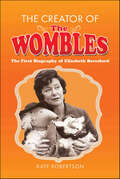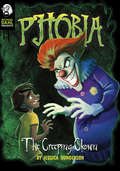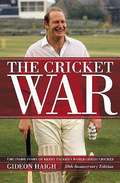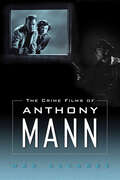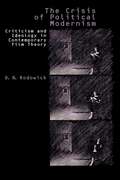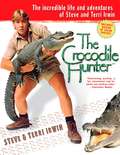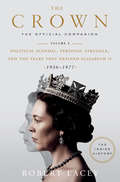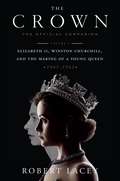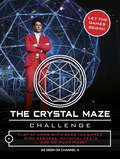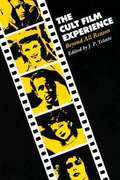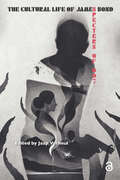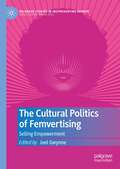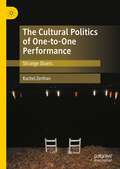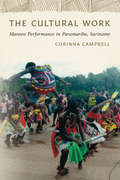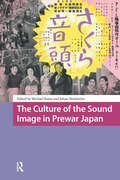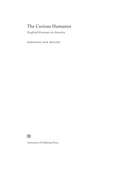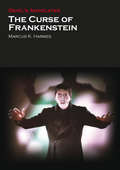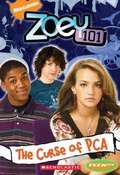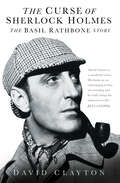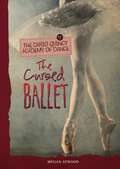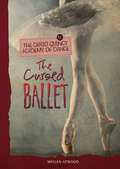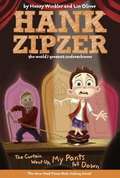- Table View
- List View
The Creator of the Wombles: The First Biography of Elisabeth Beresford
by Kate RobertsonThis is the extraordinary story of Elisabeth Beresford, creator of The Wombles, the furry, fun-loving recyclers of rubbish which became a children’s publishing and television sensation in the 1970s. What drove this imaginative and prolific writer of children’s books to invent The Wombles? From her birth in Paris in 1926 to her death in the Channel Islands in 2010, Beresford’s working life was led to the full, driven by the fear of debt. Married to the TV and radio sports commentator, Max Robertson, and with two children, Elisabeth’s life was never dull but always uncertain. In addition to writing over 140 children’s books, she wrote romantic fiction for women’s magazines, became a regular contributor to the Today program, Woman’s Hour (BBC) and Woman’s World (Central Office of Information). As a journalist she interviewed a fascinating range of people from politicians and film stars to children in the remote Australian Outback. With the publication of The Wombles, and subsequently the enchanting BBC films, Elisabeth found fame and for a very brief moment, fortune. This is the first biography of ‘Mrs Womble’ as Elisabeth was known by millions of fans. Written by her daughter with insider knowledge and access to private family archives - diaries, letters, photographs and family memories - this book relates the remarkable and often hilarious life of one of the 20th century’s most successful children’s authors.
The Creeping Clown: A Tale of Terror (Michael Dahl Presents: Phobia)
by Jessica GundersonCoulrophobia--the fear of clowns. It might seem funny, but for Josh this fear is no joke. Josh has a pulse-pounding, sweat-inducing feeling about the clown that advertises the local pizza place. Or anyone who dresses up as a clown for Halloween. When a class field trip takes him to an amusement park, Josh's friends dare him to enter the Hall of Horrors. Will one of those horrors be wearing a frizzy wig and a red nose? Josh is on his guard, but then someone else gets into trouble and needs help. Can Josh muster the courage to conquer his greatest fear and come to the rescue?
The Cricket War by Gideon Haigh
by Gideon HaighIn May 1977, the cricket world awoke to discover that a thirty-nine-year-old Sydney businessman called Kerry Packer had signed thirty-five elite international players for his own televised 'World Series'. The Cricket War is the definitive account of the split that changed the game on the field and on the screen. In helmets, under lights, with white balls, and in coloured clothes, the outlaw armies of Ian Chappell, Tony Greig and Clive Lloyd fought a daily battle of survival. In boardrooms and courtrooms Packer and cricket's rulers fought a bitter war of nerves. A compelling account of the top-class sporting life, The Cricket War also gives a unique insight into the motives and methods of the man who became Australia's richest, and remained so, until the day he died. It was the end of cricket as we knew it – and the beginning of cricket as we know it. Gideon Haigh has published over thirty books, over twenty of them about cricket. This edition of The Cricket War, Gideon Haigh's first book about cricket originally published in 1993, has been updated since.
The Crime Films of Anthony Mann
by Max AlvarezAnthony Mann (1906–1967) is renowned for his outstanding 1950s Westerns starring James Stewart (Winchester '73, The Naked Spur, The Man from Laramie). But there is more to Mann's cinematic universe than those tough Wild West action dramas featuring conflicted and secretive heroes. This brilliant Hollywood craftsman also directed fourteen electrifying crime thrillers between 1942 and 1951, among them such towering achievements in film noir as T-Men, Raw Deal, and Side Street. Mann was as much at home filming dark urban alleys in black-and-white as he was the prairies and mountains in Technicolor, and his protagonists were no less conflicted and secretive than his 1950s cowboys. In these Mann crime thrillers we find powerful stories of sexual obsession (The Great Flamarion), the transforming images of women in wartime and postwar America (Strangers in the Night, Strange Impersonation), exploitation of Mexican immigrants (Border Incident), studies of the criminal mind (He Walked by Night), and Civil War bigotry (The Tall Target). Mann's forceful camera captured such memorable and diverse stars as Erich von Stroheim, Farley Granger, Dennis O'Keefe, Claire Trevor, Richard Basehart, Ricardo Montalbán, Ruby Dee, and Raymond Burr. The Crime Films of Anthony Mann features analysis of rare documents, screenplays, story treatments, and studio memoranda and reveals detailed behind-the-scenes information on preproduction and production on the Mann thrillers. Author Max Alvarez uses rare and newly available sources to explore the creation of these noir masterworks. Along the way, the book exposes secrets and solves mysteries surrounding the mercurial director and his remarkable career, which also included Broadway and early live television.
The Crisis of Political Modernism: Criticism and Ideology in Contemporary Film Criticism
by D. N. RodowickD.N. Rodowick offers a critical analysis of the development of film theory since 1968. He shows how debates concerning the literary principles of modernism—semiotics, structuralism, psychoanalysis, Marxism, and feminism—have transformed our understanding of cinematic meaning. Rodowick explores the literary paradigms established in France during the late 1960s and traces their influence on the work of diverse filmmaker/theorists including Jean-Luc Godard, Peter Gidal, Laura Mulvey, and Peter Wollen. By exploring the "new French feminisms" of Irigaray and Kristeva, he investigates the relation of political modernism to psychoanalysis and theories of sexual difference. In a new introduction written especially for this edition, Rodowick considers the continuing legacy of this theoretical tradition in relation to the emergence of cultural studies approaches to film.
The Critical Eye: An Introduction to Looking at Movies (3rd revised edition)
by Margo Kasdan Christine Saxton Susan TavernettiAn excellent summary and profound analysis of the techniques and interpretation of movies.
The Crocodile Hunter
by Steve Terri IrwinWhen Terri Raines was twenty-seven years old, she took a vacation that changed her life. Leaving behind her wildlife rescue work in Oregon, Terri traveled to Australia, and there, at a small wildlife park, she met and fell in love with a tall, blond force of nature named Steve Irwin. They were married in less than a year, and Terri eagerly joined in Steve's conservation work. The footage filmed on their crocodile-trapping honeymoon became the first episode of T"he Crocodile Hunter," and together, Steve and Terri began to change the world. In "Steve & Me," Terri recounts the unforgettable adventures they shared -- wrangling venomous snakes, saving deadly crocodiles from poachers, swimming among humpback whales. A uniquely gifted naturalist, Steve was first and foremost a wildlife warrior dedicated to rescuing endangered animals -- especially his beloved crocs -- and educating everyone he could reach about the importance of conservation. In the hit TV shows that continue to be broadcast worldwide, Steve's enthusiasm lives on, bringing little-known and often-feared species to light as he reveals and revels in the wonders of our planet. With grace, wit, and candor, Terri Irwin portrays her husband as he really was -- a devoted family man, a fervently dedicated environmentalist, a modest bloke who spoke to millions on behalf of those who could not speak for themselves. "Steve & Me" is a nonstop adventure, a real-life love story, and a fitting tribute to a man adored by all those whose lives he touched, written by the woman who knew and loved him best of all.
The Crown: Political Scandal, Personal Struggle, and the Years that Defined Elizabeth II (1956-1977) (The Crown #2)
by Robert LaceyThe fascinating royal and social history that inspired seasons 2 and 3 of The Crown, written by the show&’s historical consultant. In this eye-opening companion to seasons 2 and 3 of Netflix&’s acclaimed series The Crown, renowned biographer—and the show&’s historical consultant—Robert Lacey takes us through the real history that inspired the drama. Covering two tumultuous decades in the reign of Queen Elizabeth II, Lacey looks at the key social, political, and personal moments and their effects—not only on the royal family but also on the world around them. From the Suez Crisis and the U.S.–Soviet space race to the legacy of the Duke of Windsor&’s collaboration with Hitler, along with the rumored issues with the royal marriage, the book provides a thought-provoking insight into the historic decades that the show explores, revealing the truth behind the on-screen drama. Extensively researched and complete with beautifully reproduced photographs, this is a unique look behind the history that inspired the show and the years that would prove to be the making of the Queen.The Crown is now available to watch on Netflix.The Crown is produced by Left Bank Pictures in association with Sony Pictures Television for Netflix.
The Crown: The Official Companion, Volume 1: Elizabeth II, Winston Churchill, and the Making of a Young Queen (1947-1955) (The Crown #1)
by Robert LaceyThe official companion to the Emmy-winning Netflix drama chronicling the reign of Queen Elizabeth II, and starring Claire Foy and John Lithgow, The Crown by Peter Morgan, featuring additional historical background and beautifully reproduced archival photos and show stills <P><P>Elizabeth Mountbatten never expected her father to die so suddenly, so young, leaving her with a throne to fill and a global institution to govern. <P>Crowned at twenty-five, she was already a wife and mother as she began her journey towards becoming a queen. <P> As Britain lifted itself out of the shadow of war, the new monarch faced her own challenges. <P>Her mother doubted her marriage; her uncle-in-exile derided her abilities; her husband resented the sacrifice of his career and family name; and her rebellious sister embarked on a love affair that threatened the centuries-old links between the Church and the Crown. <P>This is the story of how Elizabeth II drew on every ounce of resolve to ensure that the Crown always came out on top. <P>Written by the show’s historical consultant, royal biographer Robert Lacey, and filled with beautifully reproduced archival photos and show stills, The Crown: The Official Companion: Volume 1 adds expert and in-depth detail to the events of the series, painting an intimate portrait of life inside Buckingham Palace and 10 Downing Street. <P>Here is Elizabeth II as we’ve never seen her before.
The Crystal Maze Challenge: Let The Games Begin!
by Neale SimpsonThe Crystal Maze is back and there's no place like dome. Packed full of over 100 new games, mind benders and riddles, with this book you can now play the ultimate game show in the playground of your own home. Join ranks with family and friends as you travel through the four iconic zones - Aztec, Industrial, Future and Medieval - guided by Maze Master Richard Ayoade. Some games are quick, so you can have a spontaneous game if you fancy, whilst others require a bit more preparation but they can all be played with household items!Test your skill, mental and physical abilities as you try to leap around your living room without touching the floor, solve puzzles and brainteasers, and complete treasure hunts around the house, all the while trying to win the crystals before heading to The Crystal Dome ... and remembering not to leave anyone locked in any cupboards! The Crystal Maze is ready and waiting ... will you start the fans please!
The Cult Film Experience: Beyond All Reason
by J. P. Telotte"Play it again, Sam" is the motto of cult film enthusiasts, who will watch their favorite movie over and over, "beyond all reason. " What is the appeal of cult movies? Why do fans turn up in droves at midnight movies or sit through the same three-hanky classics from Hollywood's golden era? These are some of the questions J. P. Telotte and twelve other noted film scholars consider in this groundbreaking study of the cult film. The book identifies two basic types of cult films-older Hollywood movies, such as Casablanca, that have developed a cult following and "midnight movies," most notably The Rocky Horror Picture Show. Telotte, Bruce Kawin, and Timothy Corrigan offer thought-provoking discussions about why these two types of movies become cult films, the sort of audience they attract, and the needs they fulfill for that audience. Subsequent essays employ a variety of cultural, feminist, ideological, and poststructural strategies for exploring these films. In a section on the classical cult film, the movie Casablanca receives extensive treatment. An essay by T. J. Ross considers Beat the Devil as a send-up of cult films, while another essay by Wade Jennings analyzes the cult star phenomenon as personified in Judy Garland. "Midnight movie madness" is explored in essays on The Rocky Horror Picture Show, movie satires of the 1950s, science fiction double features, and horror thrillers. Illustrated with scenes from favorite movies and written for both fans and scholars, The Cult Film Experience will appeal to a wider audience than the "usual suspects. "Texas Film and Media Studies SeriesThomas Schatz, Editor
The Cultural Life of James Bond: Specters of 007
by Jaap VerheulThe release of No Time To Die in 2021 heralds the arrival of the twenty-fifth installment in the James Bond film series. Since the release of Dr. No in 1962, the cinematic James Bond has expedited the transformation of Ian Fleming's literary creation into an icon of western popular culture that has captivated audiences across the globe by transcending barriers of ideology, nation, empire, gender, race, ethnicity, and generation. The Cultural Life of James Bond: Specters of 007 untangles the seemingly perpetual allure of the Bond phenomenon by looking at the non-canonical texts and contexts that encompass the cultural life of James Bond. Chronicling the evolution of the British secret agent over half a century of political, social, and cultural permutations, the fifteen chapters examine the Bond-brand beyond the film series and across media platforms while understanding these ancillary texts and contexts as sites of negotiation with the Eon franchise. Winner of the 2022 Best Edited Collection British Association of Film, Television and Screen Studies (BAFTSS) Award.
The Cultural Politics of Femvertising: Selling Empowerment (Palgrave Studies in (Re)Presenting Gender)
by Joel GwynneThis book addresses the merits and limitations of femvertising, explores the operations of advertising and commodity feminism in a global context, and presents case studies from Anglo-American, South American and East Asian national contexts. The range of topics include the femvertising of beauty products, contraception, lingerie, breast cancer awareness, financial services and corporate branding. Focusing on the ways in which neoliberalism and postfeminism interact with foundational issues of feminist politics, the chapters in this book situate global femvertising as a complex and exciting advertising strategy which holds the potential for social change amidst an uneasy cohabitation with capitalism and commercial culture.
The Cultural Politics of One-to-One Performance: Strange Duets
by Rachel ZerihanThis monograph is the first study to critically examine works of performance made for an audience of one. Despite being a prolific feature of the performance scene since the turn of the millennium, critical writing about this area of contemporary practice remains scarce. This book proposes a genealogy of the curious relationship between solo performer and lone spectator through lineages in the histories of live art, visual art and theatre practices. Drawing on one-to-one performances by artists including Marilyn Arsem, Oreet Ashery, Franko B, Rosana Cade, Jess Dobkin, Karen Finley, David Hoyle, Adrian Howells, Kira O’Reilly, Barbara T Smith and Julie Tolentino, Rachel Zerihan produces research that is both affective and critical. This performance analysis proposes four frameworks through which to examine the significance and challenge of this work: cathartic, social, explicit and economic. One-to-one performance is proposed as a rich portal for examining the cultural politics of contemporary society. The book will appeal to students and scholars from performance studies, theatre, visual art and cultural studies.
The Cultural Work: Maroon Performance in Paramaribo, Suriname (Music / Culture)
by Corinna CampbellHow do people in an intensely multicultural city live alongside one another while maintaining clear boundaries? This question is at the core of The Cultural Work, which illustrates how the Maroons (descendants of escaped slaves) of Suriname and French Guiana, on the northern coast of South America, have used culture-representational performance to sustain their communities within Paramaribo, the capital. Focusing on three collectives known locally as "cultural groups," which specialize in the music and dance traditions of the Maroons, it marks a vital contribution to knowledge about the cultural map of the African diaspora in South America, Latin America, and the Caribbean.
The Culture of the Sound Image in Prewar Japan
by Michael Raine Johan NordströmThis collection of essays explores the development of electronic sound recording in Japanese cinema, radio, and popular music to illuminate the interrelationship of aesthetics, technology, and cultural modernity in prewar Japan. Putting the cinema at the center of a ‘culture of the sound image’, it restores complexity to a media transition that is often described simply as slow and reluctant. In that vibrant sound culture, the talkie was introduced on the radio before it could be heard in the cinema, and pop music adaptations substituted for musicals even as cinema musicians and live narrators resisted the introduction of recorded sound. Taken together, the essays show that the development of sound technology shaped the economic structure of the film industry and its labour practices, the intermedial relation between cinema, radio, and popular music, as well as the architecture of cinemas and the visual style of individual Japanese films and filmmakers.
The Curious Humanist: Siegfried Kracauer in America
by Johannes Von MoltkeDuring the Weimar Republic, Siegfried Kracauer established himself as a trenchant theorist of film, culture, and modernity, and he is now considered one of the key thinkers of the twentieth century. When he arrived in Manhattan aboard a crowded refugee ship in 1941, however, he was virtually unknown in the United States and had yet to write his best-known books, From Caligari to Hitler and Theory of Film. Johannes von Moltke details the intricate ways in which the American intellectual and political context shaped Kracauer's seminal contributions to film studies and shows how, in turn, Kracauer's American writings helped shape the emergent discipline. Using archival sources and detailed readings, von Moltke asks what it means to consider Kracauer as the New York Intellectual he became in the last quarter century of his life. Adopting a transatlantic perspective on Kracauer's work, von Moltke demonstrates how he pursued questions in conversation with contemporary critics from Theodor Adorno to Hannah Arendt, from Clement Greenberg to Robert Warshow: questions about the origins of totalitarianism and the authoritarian personality; about high and low culture; about liberalism, democracy, and what it means to be human. From these wide-flung debates, Kracauer's own voice emerges as that of an incisive cultural critic invested in a humanist understanding of the cinema.
The Curse of Frankenstein
by Marcus K. HarmesCritics abhorred it, audiences loved it, and Hammer executives where thrilled with the box office returns: The Curse of Frankenstein was big business. The 1957 film is the first to bring together in a horror movie the 'unholy two', Christopher Lee and Peter Cushing, together with the Hammer company, and director Terence Fisher, combinations now legendary among horror fans. In his Devil's Advocate, Marcus Harmes goes back to where the Hammer horror production started, looking at the film from a variety of perspectives: as a loose literaryadaptation of Mary Shelley's novel; as a film that had, for legal reasons, to avoid adapting from James Whale's 1931 film for Universal Pictures; and as one which found immediate sources of inspiration in the Gainsborough bodice rippers of the 1940s and the poverty row horrors of the 1950s. Later Hammer horrors may have consolidated the reputation of the company and the stars, but these works had their starting point in the creative and commercial choices made by the team behind The Curse of Frankenstein. In the film sparks fly, new life is created and horrors unleashed but the film itself was a jolt to 1950s cinema going that has never been entirely surpassed.
The Curse of Frankenstein (Devil's Advocates)
by Marcus HarmesCritics abhorred it, audiences loved it, and Hammer executives where thrilled with the box office returns: The Curse of Frankenstein was big business. The 1957 film is the first to bring together in a horror movie the 'unholy two', Christopher Lee and Peter Cushing, together with the Hammer company, and director Terence Fisher, combinations now legendary among horror fans. In his Devil's Advocate, Marcus Harmes goes back to where the Hammer horror production started, looking at the film from a variety of perspectives: as a loose literaryadaptation of Mary Shelley's novel; as a film that had, for legal reasons, to avoid adapting from James Whale's 1931 film for Universal Pictures; and as one which found immediate sources of inspiration in the Gainsborough bodice rippers of the 1940s and the poverty row horrors of the 1950s. Later Hammer horrors may have consolidated the reputation of the company and the stars, but these works had their starting point in the creative and commercial choices made by the team behind The Curse of Frankenstein. In the film sparks fly, new life is created and horrors unleashed but the film itself was a jolt to 1950s cinema going that has never been entirely surpassed.
The Curse of PCA (Zoey #101)
by Sarah Hines Stephens Jane MasonZoey and the gang are back for another year of laughs, friendship, pranks, and drama at PCA, in this latest chapter book based on the hit Nickelodeon show.
The Curse of Sherlock Holmes: The Basil Rathbone Story
by David ClaytonBasil Rathbone is synonymous with Sherlock Holmes.He played the Victorian sleuth in the fourteen Fox/Universal films of the 1930s and ’40s, as well as on stage and radio. For many people, he is the Holmes.Basil Rathbone grew to hate Sherlock Holmes.The character placed restrictions on his career: before Holmes he was an esteemed theatre actor, appearing in Broadway plays such as The Captive and The Swan, the latter of which became his launchpad to greater stardom. But he never, ever escaped his most famous role.Basil Rathbone was not Sherlock Holmes.In The Curse of Sherlock Holmes, celebrated biographer David Clayton looks at the behind-the-camera life of a remarkable man who deserved so much more than to be relegated to just one role.
The Cursed Ballet (The Dario Quincy Academy of Dance #3)
by Megan AtwoodEvery time the Dario Quincy Academy has performed Giselle, the ballet's lead dancer has died. That's what the rumors say, anyway. But Ophelia doesn't believe in all that. She's determined to win the lead and beat the so-called curse. As Ophelia begins sneaking out at night to practice Giselle's moves, she meets a mysterious boy hiding in the shadows. He's got great moves, and his looks aren't bad either. After a series of secret meetings, Ophelia starts to feel drained of her strength. She even blacks out during dance class. Is she just pushing herself too hard? Or are the boy and the curse connected?
The Cursed Ballet (The\dario Quincy Academy Of Dance Ser. #3)
by Megan AtwoodEvery time the Dario Quincy Academy has performed Giselle, the ballet's lead dancer has died. That's what the rumors say, anyway. But Ophelia doesn't believe in all that. She's determined to win the lead and beat the so-called curse. As Ophelia begins sneaking out at night to practice Giselle's moves, she meets a mysterious boy hiding in the shadows. He's got great moves, and his looks aren't bad either. After a series of secret meetings, Ophelia starts to feel drained of her strength. She even blacks out during dance class. Is she just pushing herself too hard? Or are the boy and the curse connected?
The Curtain Went Up, My Pants Fell Down (Hank Zipzer, the World's Greatest Underachiever #11)
by Henry Winkler Lin OliverHank Zipzer is failing math, so he has to work with Heather Payne, resident class brain, to help get his grades up. At the same time, Hank’s school is putting on a production of The King and I. As coincidence would have it, Hank is cast as the King, and Heather as Anna. But when Hank’s dad tells him he can only appear in the play if he gets a B on his next math test, Hank knows he has to hit the books. Can Hank pull through in time for the show?
The Custom of the Country: The Custom Of The Country. Elder Brother. Spanish Curate. Wit Without Money. Beggars' Bush (Globe Quartos)
by John FletcherFirst Published in 1999. Routledge is an imprint of Taylor & Francis, an informa company.
